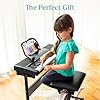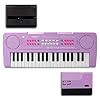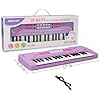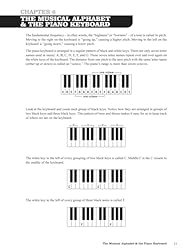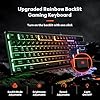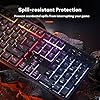Table of Contents
Developing a Good Ear for Piano Playing
Developing a good ear is essential for mastering the piano. This skill not only enhances your ability to play by ear, but also significantly improves your overall musicality, including rhythm, pitch, and tone quality. Whether you are a beginner or an advanced player, cultivating an ear for music will help in interpreting compositions effectively and aid in more expressive performances. In this introduction, we will outline the foundational steps and practices that can guide you in nurturing your auditory skills specifically tailored for piano playing.
Exercises for Pitch Recognition
Developing accurate pitch recognition is crucial for enhancing your piano playing skills. Here are some specific exercises to help improve your pitch recognition:
Best Choice Products 61-Key Electronic Keyboard Piano Portable Electric Keyboard Complete Beginner Set w/LED Screen, Stand, Bench, Headphones - Black
13% OffRockJam 61 Key Keyboard Piano Stand With Pitch Bend Kit, Piano Bench, Headphones, Simply Piano App & Keynote Stickers
$129.99 (as of December 20, 2025 13:23 GMT -08:00 - More infoProduct prices and availability are accurate as of the date/time indicated and are subject to change. Any price and availability information displayed on [relevant Amazon Site(s), as applicable] at the time of purchase will apply to the purchase of this product.)Piano Star
$0.00 (as of December 20, 2025 13:23 GMT -08:00 - More infoProduct prices and availability are accurate as of the date/time indicated and are subject to change. Any price and availability information displayed on [relevant Amazon Site(s), as applicable] at the time of purchase will apply to the purchase of this product.)Keyboard Piano for Kids, BIGFUN 37 Keys Toddler Piano Multifunction Music Educational Instrument Toy, Electronic Kids Keyboard for 3-7 Year Old Girls and Boys (Purple)
15% OffExercises for Tuning
Being able to tune your instrument correctly is as important as playing it. Here’s how you can practice to improve your tuning skills:
Learning to Identify Chords by Ear
One of the key skills in developing a good ear for piano playing is the ability to identify chords by ear. This ability allows pianists to understand and anticipate harmonic structures in music, which is essential for improvisation, composition, and arrangement. Here are detailed steps and tips to enhance your chord identification skills:
Begin by familiarizing yourself with the theory behind chords. Understand major, minor, diminished, and augmented chords along with more complex structures like seventh, ninth, and suspended chords. Learning the theory provides a solid foundation that makes auditory recognition more intuitive.
Initially, focus on identifying major and minor chords as they are the most common. Practice by listening to various chord progressions and trying to discern whether the chords are major or minor based on their sound quality—major chords typically sound happy and bright, while minor chords sound sad and somber.
How to Play Blues Piano by Ear - Book/Online Audio
Your Golden Ears: First Piano Lessons for Adult Beginners Vol. 1: Learn With 5 Minutes Daily Practice, Master Finger Dexterity & Technique Using Sheet Music, Songs, Music Notation and More!
$13.99 (as of December 20, 2025 15:53 GMT -08:00 - More infoProduct prices and availability are accurate as of the date/time indicated and are subject to change. Any price and availability information displayed on [relevant Amazon Site(s), as applicable] at the time of purchase will apply to the purchase of this product.)How to Jam - A Guide to Playing Music by Ear
$2.99 (as of December 20, 2025 15:53 GMT -08:00 - More infoProduct prices and availability are accurate as of the date/time indicated and are subject to change. Any price and availability information displayed on [relevant Amazon Site(s), as applicable] at the time of purchase will apply to the purchase of this product.)Taming the Dragon: America's Most Dangerous Highway
(as of December 20, 2025 15:53 GMT -08:00 - More infoProduct prices and availability are accurate as of the date/time indicated and are subject to change. Any price and availability information displayed on [relevant Amazon Site(s), as applicable] at the time of purchase will apply to the purchase of this product.)Understand and practice identifying chord inversions. A chord’s character can change significantly with inversions, even though the root note might not be in the base. This step significantly improves your ear for recognizing chord positions and qualities no matter how they are played.
Practice by listening to and playing different chord progressions. Use tools like piano apps, software, or YouTube tutorials that highlight chords as they play. Try to identify each chord without looking, then check your accuracy. Regular practice with varied progressions will quickly improve your ear.
Incorporate the use of ear training apps specifically designed to develop chord recognition skills. These apps often include exercises that isolate individual chords as well as chord progressions in various keys and styles, which can speed up the learning process.
Regularly play chords on the piano and attempt to sing the tonic (root) note of each chord. This exercise helps solidify the sound of the chord in your mind, making it easier to identify purely by listening. Additionally, actively listen to pieces of music and attempt to transcribe or write down the chords being used.
Record yourself playing different chords and chord progressions. Listen back to these recordings frequently and try to identify the chords without the help of visual cues. Over time, this method will enable you to more accurately and quickly identify chords by ear.
Create challenges for yourself or participate in online challenges where you need to identify chords within a piece of music or from audio clips. These challenges can be both fun and incredibly effective for honing your ear training skills.
If possible, take lessons or join workshops focused on ear training and chord identification. Learning from experienced musicians and being able to ask questions in real-time can provide invaluable insights and accelerate your learning curve.
Practicing Interval Recognition on the Piano
Developing a good ear for piano involves mastering interval recognition, which is the ability to hear and identify the distance between two notes. Here are several techniques to improve your interval recognition skills:
Simple Interval Practice
Start by learning to recognize simple intervals such as major and minor seconds, thirds, perfect fourths, and fifths. Play an interval on the piano, listen carefully, then try to reproduce it. Repeat the process, gradually including more complex intervals like sixths, sevenths, and octaves.
Interval Comparison
Practice comparing intervals by playing two different intervals back-to-back and deciding which is wider or narrower. This exercise helps in developing a relative sense of pitch distance, making it easier to identify intervals in music.
Singing Intervals
Singing intervals as you play them on the piano can significantly enhance your auditory memory and recognition skills. Start from a note, sing the next interval up or down, and then check your accuracy by playing the second note on the piano. This method reinforces the sound of each interval in your mind.
Harmonic and Melodic Intervals
Practice with both harmonic (two notes played simultaneously) and melodic (notes played in succession) intervals. Harmonic intervals help you understand chord structures better, while melodic intervals are critical for recognizing melodies.
Use Interval Reference Songs
Each interval can be associated with a song that begins with that interval, which can be extremely helpful in memorizing their sounds. For example, the first two notes of “Somewhere Over the Rainbow” form a perfect octave, and “Happy Birthday” starts with a perfect fifth.
Integrating Interval Practice in Music
As you become more comfortable with intervals, start to listen actively to pieces you enjoy and identify the intervals used. Try to play by ear the melodies and harmonies to reinforce your skills further.
Using Apps and Online Tools
Utilize technology in your training routine. Many apps and websites offer interactive interval recognition exercises that provide immediate feedback, which is invaluable for rapid learning and correction.
Using Ear Training Apps to Enhance Listening Skills
Utilizing ear training apps is an effective method to develop your listening skills for piano playing. These apps are designed to systematically improve your ability to recognize intervals, chords, scales, and rhythms, essential components in developing a good ear for music.
Selection of Apps: Choose an app that suits your level and goals. Some popular apps include Tenor, Perfect Ear, and EarMaster, which offer exercises ranging from basic to advanced levels.
Customizable Exercises: Look for apps that allow customization of exercises. Tailoring the drills to focus on areas you find challenging makes your practice more effective and relevant. For instance, if you struggle with identifying intervals, you can set more exercises around this skill.
Progress Tracking: Use apps that provide feedback and track progress. This feature helps you identify areas of improvement and areas that need more attention. It’s crucial for measuring your growth over time and staying motivated.
Interactive Learning: Engage with apps that include interactive learning tools such as real-time feedback and gamified learning experiences. These features make the learning process engaging and can significantly enhance your auditory memory and recognition skills.
Daily Practice: Incorporate ear training into your daily practice routine. Even short, consistent sessions can lead to substantial improvements. Most apps offer daily training programs that can adapt to your evolving skill level.
Integration with Instrument Practice: Combine app-based ear training with actual piano playing. Some apps come with features that allow integration with real instruments. This dual approach helps bridge the gap between theoretical knowledge and practical application.
By incorporating these strategies and regularly using ear training apps, you can effectively enhance your listening skills, a core component of successful piano playing.
Applying Ear Training to Improvisation
Improvisation is a key component in many musical genres, including jazz, blues, and classical music. For pianists, the ability to improvise is greatly enhanced by strong ear training. Successful improvisation relies on the ability to listen and respond to music in real time, creating spontaneous and cohesive melodies and harmonies that complement the existing musical context.
Developing Motivic Ideas: Start by improvising simple motifs (short musical ideas) based on the harmonic structure of the piece you are playing. Train your ear to recognize chord progressions and use them to create motifs that you can develop and vary throughout your improvisation.
Understanding Chord Tones and Scales: A thorough knowledge of scales and chord tones is crucial for effective improvisation. Use ear training to identify and internalize the sound of different scales and chord inversions, enabling you to conjure the right notes that fit over any given chord during improvisation.
Call and Response Techniques: Listening is as important as playing when it comes to improvisation. Practice call and response with recordings or with other musicians. Focus on echoing phrases, adapting them, and responding creatively. This method improves your aural skills and your capacity to interact musically with others.
Employing Rhythmic Variation: Rhythm is a vital aspect of improvisation. Use ear training to digest complex rhythms and reproduce them at the piano. Experiment with different rhythmic patterns and syncopation to add interesting variations to your improvisations.
Harmonic Awareness: Being aware of the harmonic movement in music while you improvise is vital. Train your ear to anticipate and understand chord changes, playing notes that highlight the function of the chords in the progression. This can be achieved by practicing chord changes and substitutions, thus gaining a deeper understanding and hearing how different chords relate and resolve.
Conclusion
Developing a good ear for piano playing is essential for mastering musical interpretation, improvisation, and enhances overall playing experience. By consistently employing techniques such as ear training exercises, singing along to melodies, playing by ear, and using technology like apps and software, pianists can significantly improve their aural skills. Regular practice and patience are key, as is the willingness to listen critically and with focus. Engaging with a variety of music genres also broadens the auditory palette, enriching one’s musical sensitivity and understanding. Ultimately, the journey towards developing a keen musical ear supports a deeper connection with music, enabling pianists to perform with greater expression and nuance.





